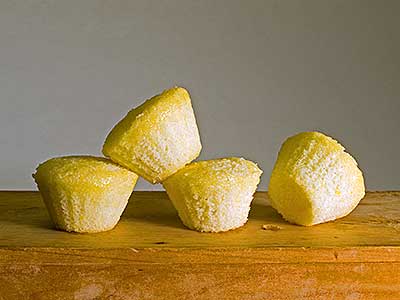June 10, 2013
Mignardise

les petits gâteaux de nombreuses saveurs
(little cakes of many flavors)
Cupcakes are the libertarians of the food world. Even if they look the same as the others in the box, each is an individual meant to be the snack of only one person. Cupcakes aren’t team players. Neither are the people who consume them. No one shares a cupcake, especially children. Cupcakes give children an excuse to claim something is just theirs. No one else can touch it.
It’s not really about the cupcake. It’s all about the icing. Watch a kid eat a cupcake. You’ll see them lick off the icing and maybe not bother to eat the cake below it. Ask for a bite, and you’ll be lucky if the worse you get is an evil-eyed stare.
If you prepare a normal cake for the child’s birthday, they grumble because they have to share it with their guests. But make a bunch of cupcakes, and both host and guests are happy. They each get their own.
Now that there are books dedicated to cupcakes and stores that produce nothing but cupcakes, I find the whole concept even more disgusting. When Amelia Simmons was baking cakes in small ceramic cups in 1796, did she fill them with devil’s food cake, yellow cake, or white cake that tasted like a reject from some box? I doubt it. Look at her recipe.
A light Cake to bake in ſmall cups.
Half a pound ſugar, half a pound butter, rubbed into two pounds flour, one glaſs wine, one do. roſewater, two do. emptins, a nutmeg, cinnamon and currants.
That sounds great. No icing, just cake. And a cake with character. If cupcakes were like this, I’d recommend them hardily.
Making interesting, classic cakes presents a challenge for those opposed to icing. Many classic cakes in our modern times are a combination of cake and icing. Devil’s food cake is an iced layer cake. Chiffon cake is an iced layer cake. Traditional icing-free cakes like pound cakes are even hard to find commercially without something drizzled on top. As a nation, we are obsessed with icing.
In my search for ideas for amuse-bouches and mignardises, I keep my feelers out to a variety of sources. No media is off-limits. I go to expensive conferences hoping to stimulate my subconscious. I page through books. I eat fancy meals in fancy restaurants. I’m always looking. Recently, I ran across a book by Pierre Gagnaire, 175 Home Recipes with a Twist. Gagnaire is known for his unusual and off-the-wall creations. Maybe one of these “twisted” recipes would stir up the old thought juices.
One did, but not necessarily in the right way. In the breakfast section on page 38, I found a recipe for a Lemon Chiffon Cake. It seemed out of place. I don’t know what the cake was called in the original French edition. Maybe the term “chiffon” was added by the translator? There seemed to be little similarity between this cake and a description that I’ve read of Henry Baker’s 1927 original chiffon cake. It’s not even similar to Martha Stewart’s version.
So I didn’t feel any guilt—as if I ever do—simplifying Gagnaire’s recipe to make little cakes for mignardises. My mini-cakes are even farther away from a traditional chiffon cake. They only have three ingredients: eggs, sugar, and flour. Plus you can flavor them in a myriad of ways, as you can see below after the recipe.
45 g (scant 1⁄4 c)
superfine granulated sugar
1
extra-large egg
40 g (1⁄3 c)
cake flour
1. Preheat oven to 180 °C (355 °F). Lightly spray the cavities of a silicone mini-cake mold with baking release spray.
2. Whisk the sugar and egg together until airy and light. Stir in the flour. Divide the batter among the cavities of the mold until they are about three-fourths full.
3. Place the mold on a baking sheet. Place the pair in the oven, and bake until golden and done, about 15 minutes.
4. Unmold as soon as the silicone mold can be handled.
Yield: About 20 little cakes.
There are many ways you can flavor the cakes. Once they are cool, they can either be injected with or soaked in the flavoring. What to use? Whatever you wish. Syrups work great. I’ve tried both a homemade Meyer-lemon syrup and a commercial bacon-flavored syrup. Heavily flavored liquors such as amaretto or Kahlua work nice. Even a good quality cognac or poire Williams would be stupendous. Using a syringe makes it possible to inject a measured amount into the very center of each cake so it does not become too soggy. Just hide the injection site on the bottom when you serve the cakes.
© 2013 Peter Hertzmann. All rights reserved.
